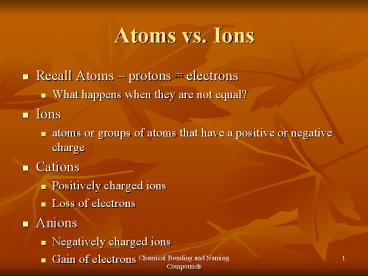Atoms vs. Ions PowerPoint PPT Presentation
1 / 16
Title: Atoms vs. Ions
1
Atoms vs. Ions
- Recall Atoms protons electrons
- What happens when they are not equal?
- Ions
- atoms or groups of atoms that have a positive or
negative charge - Cations
- Positively charged ions
- Loss of electrons
- Anions
- Negatively charged ions
- Gain of electrons
2
What are ionic compounds?
- Electrically neutral compound formed from cations
and anions - Usually metals and nonmetals
- Most are crystalline solids at room temperature
3
What is a molecule?
- Monatomic single atoms
- Noble gases (He, Xe)
- Diatomic Molecules
- smallest electrically neutral group of atoms that
act as a unit of substance - H2, O2, F2, Br2, I2, N2, Cl2
- Molecular (Covalent) Compounds
- Mostly 2 or more nonmetals
- Low MP, BP
- Examples HCl, H2O
4
Distinguishing between two types of chemical
formulas
- Chemical formula
- Shows kinds and numbers of atoms in the smallest
representative unit of the substance - Two Types of Compounds
- Molecular formulas
- Molecular compounds smallest unit
- 7 diatomic molecules
- Elements that commonly exist as molecules
- Formula Units (Ionic Compounds)
- No separate molecular unit, continuous array of
ions - Lowest whole number ratio of ions in compound
5
Determining Charge of Ions
- Which elements form what charges?
- Metals tend to lose electrons (positive charges)
- Nonmetals tend to gain electrons (negative
charges) - Monatomic ions groups of Periodic table
- Roman numerals for transition metals multiple
charges - Examples of ions and charges from P-table
- What is the charge? (S, Pb, Zn, Ar, Br)
- Write symbols for ions, name ions from charges
- Oxide, lead(II), lithium, nitride, cupric,
fluoride - Ba2, I-, Ag, Hg2, P3-, Sn4
6
Polyatomic ions
- Group of atoms with a charge
- Tightly bound groups that behave as a unit and
carry a charge - Most end in ite, -ate, some exceptions (cyanide,
ammonium) - Memorize table 9.3 by Exam (Friday)
7
Writing Formulas and Naming Ionic Compounds
- Binary Ionic Compounds (Formulas)
- 1) 2 elements
- 2) Write charges of ions
- 3) Balance charges
- Lowest ratio
- 3a) Criss-cross method, reduce
- Binary Ionic Compounds (Naming)
- 1) Metal, nonmetal with ide
- 2) Roman Numerals
- Examples potassium nitride, sodium oxide,
copper(II) sulfide, tin(IV) sulfide, potassium
chloride, magnesium nitride - Examples (names) Cs2O, CoI2, AlF3, FeS, CaO,
Cu2Se
8
Ternary Ionic Compounds
- Contains polyatomic ions
- Use charges, balance with parentheses
- What to do with Polyatomic Ions?
- Remember to treat PI as one unit Install
Parentheses - Criss-Cross method
- Examples potassium sulfate, magnesium
hydroxide, calcium carbonate, tin(IV) dichromate - Examples LiCN, Sr(H2PO4) 2, (NH4) 2C2O4,
Fe(ClO3) 3
9
Writing Formulas and Naming Molecular Compounds
- What about formulas for molecular compounds
ones that are not ionic? - Rules
- No ionic charges
- Greek prefixes (table 5.5)
- Naming
- 1st element (no mono), 2nd element (-ide)
- Drop vowel when name of 2nd element begins with
vowel - Dihydrogen Monoxide
- Website
10
Practice
- N2O, PCl3, AlCl3, SF6
- carbon tetrabromide, dinitrogen tetrahydride,
boron trichloride, diphosphorus trioxide - Formula B-I-N-G-O
- Now, youre ready to play!
11
END
12
Experimental Data Led to Two Major Laws
- Law of Definite Proportions
- Samples of any chemical compound, masses of
elements are always in the same proportions - Law of Multiple Proportions
- 2 elements forming more than 1 possible compound
- Keep in smallest whole numbers
13
Lab 4 Periodic Properties
- Objectives Measure densities and solubilities to
look at trends in Periodic table. - Techniques Volume displacement, solubility
- Data for Silicon on Chalkboard in Lab
- Safety Barium (toxic), Acid GG _at_ all times
- Formal Report CTD reporting, intervention
14
Chemical Bonding and Naming Compounds
- To insert your company logo on this slide
- From the Insert Menu
- Select Picture
- Locate your logo file
- Click OK
- To resize the logo
- Click anywhere inside the logo. The boxes that
appear outside the logo are known as resize
handles. - Use these to resize the object.
- If you hold down the shift key before using the
resize handles, you will maintain the proportions
of the object you wish to resize.
- Origins of Element Names
- Old Element Name Quiz
- Fun Brain Element Quiz
- Latin Names
- Oxyrich Water
- Oxyrich Website
- Refuting Claim
15
Exit Slips
- Atomic Structure
- Draw an atomic model for a Beryllium-9 atom
- Naming Compounds
- Write the correct chemical formula/name for
- Barium Nitrate
- Diphosphorus Pentoxide
- CuCl2
- SeO2
- General Comments
- Anything confusing, Pace, Structure, Lighting,
etc.
16
Exit Slips 1ST Week feedback
- Congratulations! Youve survived the first week
(really, the first 3 months) of Chemistry! - Now, for some feedback on a separate scrap of
paper, please answer the following anonymously - 1) How does your current grade match your effort
grade? - 2) What do you think of the current structure of
the class? (Powerpoints, HW, Labs,
Quizzes/Tests) - 3) What are some suggestions to make your next 2
weeks even better? Any other comments? - Thanks Ill try to take these suggestions into
account for our last 2 weeks. Great job so far!

